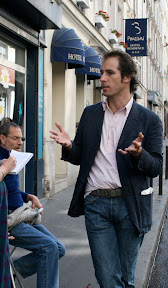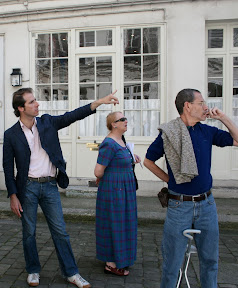One of our very favorite organizations in the world of travel is Context Travel. We've interviewed them before, and I am always impressed by the scholarly tone that they bring to travel. I recently asked Paul Bennett, founder of Context Travel, to let us interview some of his docents. Luckily for us, we have been able to do just that. Here's the second of several excellent interviews with a docent of Context Travel, Peter Miller, who is based in Paris.

WE: Please tell us about your walking tour with Context Travel...
PM: I lead several seminars for Context in Paris, including a walking tour of the Nouvelle Athenes ("New Athens") neighborhood in the 9th arrondisement. Constructed in the 19th century, its neo-classical architecture and mixture of artistic and literary luminaries made it one of the most modern and vibrant areas of Paris during the Romantic period. Beginning with the imposing church of Notre Dame de Lorette, whose sober exterior stands in marked contrast to the formerly sumptuous (now somewhat forlorn) interior, I discuss how the quartier encapsulates the political, social and artistic developments in the French capital from the Restoration (1815-1830) through the July Monarchy (1830-1848) and the Second Empire (1852-1871). We look at key buildings, including the house and studio of painter Ary Scheffer, which is now the Musee de la Vie Romantique, and the residential complex called the Square d'Orleans, with its neo-classical elements strongly influenced by urban planning in London. Mixing history, literature, architecture, and interspersed with discussion of major artists, writers and musicians, all of whom lived in worked in the neighborhood (Eugene Delacroix, Ary Scheffer, Horace Vernet, Theodore Gericault, Paul Gavarni, George Sand, Frederic Chopin, Georges Bizet), this seminar revisits the Romantic period through close study of this unknown corner of Paris.
I also conduct walking tours through the Musee d'Orsay. I introduce visitors to the major themes in 19th century French painting and sculpture from 1848 to 1900, with specific focus on the challenge posed by the Impressionist movement and its immediate precursors to the Academic system in France. Paying close attention to artistic technique and subject matter, as well as the institutional history of exhibitions, markets and state and private sponsorship of the arts, I help clients see how the Impressionists overturned the cornerstones of art production after 1860. Violating long-entrenched conventions governing how paintings should be constructed and what subjects they should represent, the Impressionists, inspired by the example of Manet, broke with the neo-classical tradition inculcated by Academic teaching and depicted scenes from modern life in a more spontaneous manner, attempting to capture the fleeting, ephemeral sensations of modern life in Paris. We work out together what is meant by such terms as Realism by paying close attention to specific paintings by Manet, Courbet, Monet, Renoir, Caillebotte and others.
In the Louvre, I lead seminars concentrating on Italian painting and sculpture from the early Renaissance through the Baroque, an itinerary that considers masterpieces by Cimabue, Giotto, Paolo Uccello, Botticelli, Michelangelo, Leonardo, Raphael, Titian, Veronese, Bronzino and Caravaggio. I also introduce groups to the history of French painting from the French Renaissance through the Romantic period.
WE: What is your background; what led you to be interested in this city and subject matter?
PM: I studied history as an undergraduate at Northwestern University (B.A. 1990) before working as a history teacher at an International School in Rome for four years. In 1996, I returned to graduate school in Art History, completing a two-year M.A. at Williams College. I then went on to obtain a Ph.D. in Art History from the Institute of Fine Arts/New York University, where I concentrated on Modern Art (1780-1945) studying under Robert Rosenblum and Linda Nochlin. My thesis considered the images painted by Romantic artist Theodore Chasseriau resulting from his voyage to North Africa in 1846.
In 2000, I received a grant from the Metropolitan Museum of Art in New York, where I had worked as an intern in the department of 19th century painting, to complete my dissertation research in Paris. As I worked on my dissertation, which I defended successfully in 2003, I remained in Paris to work on several projects, including a retrospective consecrated to Chasseriau (Paris-New York-Strasbourg, 2002), and an exhibition that I co-curated of work by French painters who traveled in Algeria in the 19th century, which was held at the Institut du monde arabe in Paris.
In 2004, I was hired by the Musee d'Orsay's education department to program and adminster guest lectures and scholarly symposia, a job that I continue to perform in addition to my work as a freelance curator. I have contributed articles on to the Art Bulletin and Visual Resources, in addition to writing essays and entries for the catalogues the the above- mentioned exhibitions, as well as the catalogue accompanying the retrospective dedicated to J.A.D. Ingres at the Louvre in 2007. One of my special interests is the revival of mural painting in mid-nineteenth-century Paris and, in particular, the way that archaeological investigations in North Africa after 1830 infused monumental painting with new allegorical meaning. The subject of an article published in the Art Bulletin in 2004 was the mural cycle painted byChasseriau in the grand stairhall of the Palais d'Orsay, built between 1804 and 1844 on the site where the Musee d'Orsay now stands. Once the repository of paintings by many of th emost important artists of the Romantic period, the Palais d'Orsay was destroyed by a fire in 1871 during the Commune, a popular uprising sparked by the fall of Napoleon III. It is thus appropriate that the current role of the Gare d'Orsay, a former train station converted into a museum of nineteenth-century art, to a certain extent brings those works lost in the conflagration back to life. The musee d'Orsay is a rich institution not only for the pictures and sculptures currently on display, but also for the historical resonance of the site on which it stands. It is precisely this kind of layering and dialogue between periods and artists that I emphasize in my walks.
My interest in the Nouvelle Athenes neighborhood grew out of my dissertation research. Chasseriau had his house and studio there, in a lovely verdant street called avenue Frochot, which was laid out on an English plan, very unusual in Paris at the time. As I worked out the geography of his artistic life, I learned more and more about the architecture and social network animating this particular corner of the capital.

WE: What things do you love to share, on your walking tours?
PM: I love to see how visitors on the Nouvelle Athenes tour begin to see that Paris is not as architecturally uniform as it seems at first. I love opening their eyes to different architectural styles, introducing the notion that the Paris they see today was largely the product of the 19th century and its embrace of eclectic historicist architectural influences.
WE: What is unique about your Context Tour?
PM: Its multi-disciplinary approach: the way I weave together history, urban planning, architecture, art history, literature, anecdotes, in a way that brings alive an epoch and a neighborhood that was the expression of a complex period. The material is rich and some of the figures I refer to might not be familiar to everyone, but the walk is a lively and amusing discussion of the way Paris has changed from one period to another. It offers a panoramic introduction to the way the 19th century transformed Paris into the model modern European city hosting a thriving artistic and literary culture.
WE: Thanks so much, Peter! Your work is inspiring, to say the least. I can't wait to come to Paris and learn with you!
For more information on Context Travel, and to book a tour with Peter, please see: http://www.ContextTravel.com
All photos provided by Context Travel.
